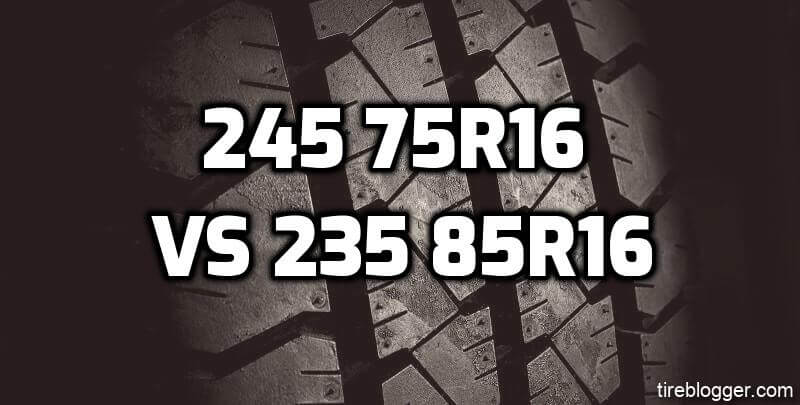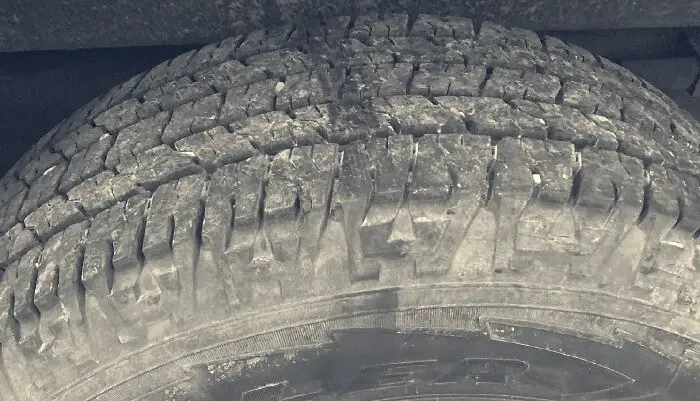Tire Size 235/85r16 vs 245/75r16

The tire sizes 235/85R16 and 245/75R16 are very similar, but there are some key differences. The 235/85R16 tire is slightly wider and has a taller sidewall than the 245/75R16 tire.
This means the 235/85R16 tire will have a slightly larger diameter and provide a smoother ride. However, the 245/75R16 tire will have a slightly larger contact patch, providing better traction.
245/75r16 vs 235/85r16 Table
For a comprehensive breakdown of the variances between 235/85R16 and 245/75R16 tire sizes, check out this handy comparison table.
| Feature | 245/75r16 | 235/85r16 | Difference |
|---|---|---|---|
| Diameter inches | 30.47 (773.9) | 31.73 (805.9) | 1.26 (32) |
| Width inches | 9.65 (245) | 9.25 (235) | -0.39 (-10) |
| Circum. inches | 95.72 (2431.28) | 99.68 (2531.81) | 3.96 (100.53) |
| Sidewall Height | 7.23 (183.75) | 7.86 (199.75) | 0.63 (16) |
| Revolutions | 661.93 (411.31) | 635.65 (394.97) | -26.28 (-16.33) |
Overall Diameter
The overall diameter of a tire is a crucial aspect of your vehicle’s performance and ride comfort. It also directly affects the accuracy of your speedometer.
The 235/85r16 tire has an overall diameter of 31.73 inches (805.9mm), 1.26 inches (32mm) larger than the 245/75r16’s diameter of 30.47 inches (773.9mm). This difference represents a 4.1% increase.
A larger diameter usually provides better stability and ride comfort due to increased surface contact. However, it might negatively affect acceleration and fuel efficiency as larger tires add rotational mass.
Section Width
The section width is the distance across the tire’s widest point. This width impacts a tire’s grip, handling, and ride quality. The 245/75r16 tire has a width of 9.65 inches (245mm), which is slightly wider by 0.39 inches (10mm) or 4.1% compared to the 235/85r16 tire width of 9.25 inches (235mm).
The wider tire might offer a marginal increase in surface contact, providing slightly improved grip and traction. However, wider tires might also experience more drag, impacting fuel efficiency.

Circumference
The circumference of a tire is the distance around the tire at its widest point. This impacts how the tire fits the wheel and rolls on the road.
The 235/85r16 tire, with its larger diameter, also has a greater circumference of 99.68 inches (2531.81mm), a 4.1% increase compared to the 245/75r16 tire’s circumference of 95.72 inches (2431.28mm).
The larger circumference implies that the vehicle will cover more ground per tire revolution, potentially leading to better fuel efficiency during highway driving, but it can also affect acceleration.
Revolutions Per Mile
Revolutions per mile (RPM) refers to the number of times a tire revolves in one mile. Lower RPM usually means better fuel efficiency but slower acceleration.
Given their larger diameter and circumference, 235/85r16 tires have fewer revolutions per mile (635.65 RPM) compared to the 245/75r16 tires (661.93 RPM), a decrease of 4%.
With fewer revolutions per mile, the 235/85r16 tires may provide better highway fuel efficiency as they cover more ground per revolution. However, this could lead to less responsive handling and acceleration.
Sidewall Height
The sidewall height is the vertical distance from the rim to the tread. It affects ride quality and handling characteristics.
The sidewall height for the 235/85r16 tire is 7.86 inches (199.75mm), about 0.63 inches (16mm) or 8.7% higher than the 245/75r16’s sidewall height of 7.23 inches (183.75mm).

A taller sidewall typically absorbs more road imperfections, providing a smoother ride. However, it can reduce handling precision and increase cornering roll due to more flex and less lateral stability.
Wheel Size
Both 235/85r16 and 245/75r16 tires are designed for 16-inch wheels, given the ’16’ in their identifiers. The ‘r’ in their identifiers means they are both Radial tires, the most common type of tire construction known for their durability and longevity.
Alternative Tire Size of 235/85r16
The overall diameter of the replacement tires should remain within 3% of that of the original tires.
| Tire Size | Overall Diameter | Difference |
|---|---|---|
| 235/80R16 | 30.8″ (782 mm) | -3% |
| 345/55R16 | 30.9″ (786 mm) | -2.5% |
| 225/85R16 | 31″ (788 mm) | -2.2% |
| 295/65R16 | 31.1″ (790 mm) | -2% |
| 275/70R16 | 31.2″ (792 mm) | -1.7% |
| 265/75R16 | 31.7″ (804 mm) | -0.2% |
| 285/70R16 | 31.7″ (806 mm) | 0% |
| 225/90R16 | 32″ (812 mm) | 0.7% |
| 375/55R16 | 32.2″ (818 mm) | 1.5% |
| 265/80R16 | 32.7″ (830 mm) | 3% |
Alternative Tire Size of 245/75r16
The replacement tires must not exceed a 3% difference in overall diameter compared to the original tires.
| Tire Size | Overall Diameter | Difference |
|---|---|---|
| 315/55R16 | 29.6″ (752 mm) | -2.8% |
| 247/70R16 | 29.6″ (752 mm) | -2.8% |
| 235/75R16 | 29.8″ (758 mm) | -2.1% |
| 255/70R16 | 30.1″ (764 mm) | -1.3% |
| 275/65R16 | 30.1″ (764 mm) | -1.3% |
| 215/85R16 | 30.4″ (772 mm) | -0.3% |
| 285/65R16 | 30.6″ (776 mm) | 0.3% |
| 265/70R16 | 30.6″ (778 mm) | 0.5% |
| 235/80R16 | 30.8″ (782 mm) | 1% |
| 345/55R16 | 30.9″ (786 mm) | 1.6% |
| 225/85R16 | 31″ (788 mm) | 1.8% |
| 295/65R16 | 31.1″ (790 mm) | 2.1% |
| 275/70R16 | 31.2″ (792 mm) | 2.3% |
Our Observation
Ultimately, choosing between these two tire sizes depends on your specific needs and priorities. If fuel efficiency and ride comfort on highways are your primary concerns, the 235/85r16 might be the better option due to its larger diameter and higher sidewall.
However, if you prioritize handling precision, better traction, and responsive acceleration, the 245/75r16, with its wider section width and higher RPM could be the superior choice.
Regardless of your choice, ensure your vehicle’s specifications can accommodate the tire’s measurements, and remember that the above differences, while statistically significant, might not translate into noticeable changes in everyday driving. Always consult a tire professional to understand the best fit for your vehicle and driving conditions.

Meet Caitlin McCormack, a Tire Size Expert and Blogger Passionate About Everything Related to Tires. With Years of Experience in the Tire Industry, Caitlin Has Become an Expert in Tire Sizes and Their Impact on Vehicle Performance.
